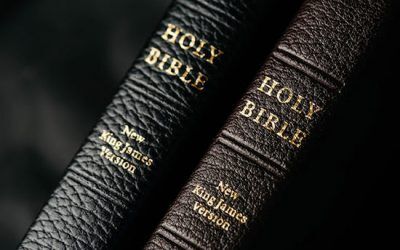The Seventh-day Adventist Church believes in the doctrine of the Trinity, the three-in-one Godhead of Father, Son, and Holy Spirit. We believe that all three members of the Godhead are fully God, that they have different functions but are united in purpose.
In this post, we’ll look at the following aspects of this belief:
- What the Trinity is
- What the Bible teaches about the Trinity
- The Trinity in Christian history
- The Trinity in Seventh-day Adventism
- How the Trinity reveals the character of God
But first, here’s the official statement of the Adventist Church on this belief:
“There is one God: Father, Son, and Holy Spirit, a unity of three coeternal Persons.
God is immortal, all-powerful, all-knowing, above all, and ever present. He is infinite and beyond human comprehension, yet known through His self-revelation.
God, who is love, is forever worthy of worship, adoration, and service by the whole creation.”
Let’s look further into what this means and why it matters.
What is the Trinity?
The word trinity comes from several European languages (Middle English trinite, Anglo-French trinité, and Latin trinitat) and simply means a state of being threefold.1 Its use in describing the unity of the three persons of the Godhead began around the 200s AD.2
The Trinity is the idea that though God is one (Galatians 3:20), He is composed of three distinct “persons” (for lack of a better term)—God the Father, God the Son (Jesus), and God the Holy Spirit.
Together they are the Godhead or the triune God. The names of each of them represent their role toward humanity.
The Father is the creator and overseer of all (John 1:3, Colossians 1:16).
The Son is the mediator who became a human and chose to die on the Cross to save us from our sin sickness. He made salvation possible for us, even though we’re fallen and imperfect (2 Corinthians 5:21, 1 John 3:16). His sacrifice set Him up to be our “great high priest” who can empathize with everything each one of us has gone through (Hebrews 4:14-16, ESV).
The Holy Spirit is the agent by which the Godhead makes things happen among humanity. It’s also the way Jesus can still be with us, even though He left us in person almost 2000 years ago. Through the Holy Spirit, God guides and influences us. He is the power and wisdom of God working within us (Acts 1:8, Isaiah 11:2).
Highly influential author and theologian on this topic and professor of theology at Phoenix Seminary, Wayne Grudem wrote this about the Godhead:
“God eternally exists as three persons, Father, Son, and Holy Spirit, and each person is fully God, and there is one God.”
In that one sentence, he captures the essence of the doctrine of the Trinity. And it is also how Adventists today view the nature of God.
It may seem hard for us to wrap our minds around the idea of the three-part nature of one God.
But think of it, we are dealing with the very nature of the almighty Creator of the universe (Genesis 1:1; John 1:1–3).
There are many aspects of the created world that are filled with mysteries humans can’t fully comprehend.
Like how water has properties that scientists can’t explain to this day.
And phenomena like bird migration—how birds know where to fly and when to fly.
Also how, to this day, scientists and philosophers still can’t agree on a single definition of the word life.
The best we can do is use metaphors and analogies, which aren’t perfect but can point us in the right direction.
That’s why you may hear of the Trinity being likened to the three parts of an egg (shell, white, yolk), the three forms of matter (solid, liquid, gas), or a ray of light that forms different colors when refracted by a prism.
But what exactly does the Bible specifically say about the Trinity? We’ll look at that next.
What the Bible teaches about the Trinity—God the Father, Son, and Holy Spirit
While the Bible doesn’t explicitly use the word trinity, the concept is present throughout the Word of God.2 In verses such as Genesis 1:26, John 10:30, Matthew 3:16-17, Matthew 28:19, we find abundant evidence of a three-in-one God. And Scripture uses words like Us, Son (God referring to Jesus), and Spirit (referring to the Holy Spirit).
Let’s look at some Bible verses about the Trinity.
The Trinity in the Old Testament
Adventists and other Christians see references to the Trinity in the first chapter of the Old Testament, when God created our world, the life on it, and especially human beings.
Here is how the creation of humanity was first expressed:
“Then God said, ‘Let Us make man in Our image, according to Our likeness’” (Genesis 1:26, NKJV).
Some have argued that the “Us” and “Our” are referring to God and angels working together to create humanity. But nothing in the Bible ever teaches that angels can also be creators of this level since they themselves are created beings.
Instead, this text portrays God, talking about Himself, but in plural terms. In fact, the Hebrew word for God, Elohim, is a plural noun.
There are a few other times in the Old Testament when God says “us” and seems to be having a discussion within the Godhead:
- “Behold, the man has become like one of us, to know good and evil” (Genesis 3:22, NKJV).
- “Come, let us go down and there confuse their language” (Genesis 11:7, NKJV).
- “Whom shall I send, and who will go for us?” (Isaiah 6:8, NKJV).
- “Hear, O Israel: The Lord our God, the Lord is one!” (Deuteronomy 6:4, NKJV).
Then, Isaiah 48:16–17 refers to all three members of the Godhead: the Father, Son, and Holy Spirit. God the Son talks of being sent by God the Father with His Spirit.
““Come near to Me, hear this: I have not spoken in secret from the beginning from the time that it was, I was there. And now the Lord God and His Spirit have sent Me. Thus says the Lord, your Redeemer, the Holy One of Israel, ‘I am the Lord your God, who teaches you to profit, who leads you by the way you should go” (NKJV).
This is just one of the many times the Holy Spirit is mentioned in the Old Testament, in close connection to or as an extension of God.3
The teaching of the plural nature of God in the Old Testament helps set the groundwork for the New Testament teaching of the Trinity.
The Trinity in the New Testament
Photo by James Coleman on Unsplash
The New Testament is where the doctrine of the Trinity is most clearly taught.
It appears in the Gospels (the four accounts of Jesus by Matthew, Mark, Luke, and John) as well as in the letters written by Paul and others. It’s also taught in the last book of the Bible, Revelation.
In the New Testament, besides the obvious status of God the Father as fully divine, the full divinity of Jesus Christ is taught as well.
In fact, the common word for God in the New Testament is the Greek word theos. This is the foundation of the word theology, which is the study of God. The word theos (in various grammatical forms) is used over and over to refer to God the Father (1 Peter 1:2; James 2:23; Hebrews 12:23).
Yet, this same word for God, theos, is used about half a dozen times by Paul, John, and Peter to refer directly to Jesus Himself.4
For example, John wrote:
““In the beginning was the Word [Jesus], and the Word was with God, and the Word was God. He was in the beginning with God. All things were made through Him, and without Him nothing was made that was made” (John 1:1–3, NKJV).
All the Greek terms for God there come from theos.
He also calls Jesus “the Word” and then says that the Word “was with God, and the Word was God.” A representation of both the Father and Jesus as God, alluding to Creation.
What’s more, Jesus’ own words affirm the oneness He has with the Father and the Holy Spirit:
- Jesus said, “I and the Father are one” (John 10:30, NKJV).
- He told His followers about the many ways He and the Father are united and that no one can even approach the Father except through Him (John 5:19; 6:38; 14:6–14; 16:28).
- Jesus said that the Holy Spirit is the helper or comforter that would guide humanity after He went back to heaven (John 14:16–18).
Because of Jesus’ oneness with the Father and the Holy Spirit, His death on the Cross can open the path of redemption for humanity.
The one who died on the cross was the eternal God Himself. The Creator loved us so much that He was willing to die in our stead. He did this so that we as sinners could receive the promise of eternal life.
Paul showed this to be true when he wrote:
“But God demonstrates His own love toward us, in that while we were still sinners, Christ died for us” (Romans 5:8, NKJV).
During Jesus’ baptism at the beginning of His public ministry, all three members of the Godhead were present:
“The heavens were opened to Him, and He saw the Spirit of God descending like a dove and coming to rest on Him; and behold, a voice from heaven said, ‘This is My beloved Son, with whom I am well pleased’” (Matthew 3:16–17, ESV).
As for the Holy Spirit, many texts in the New Testament make it clear that the Holy Spirit is equal to the Father and the Son, as opposed to being an impersonal force.
For instance, when Jesus sent His followers out to spread the Gospel to the world, He said:
“Go therefore and make disciples of all the nations, baptizing them in the name of the Father and of the Son and of the Holy Spirit” (Matthew 28:19, NKJV).
They were to baptize in the name of the Father, who is God. They were to baptize in the name of the Son, who is God. And they were also to baptize in the name of the Holy Spirit, who is God.
In the book of Acts, two church members, Ananias and his wife Sapphira, lied about how much money they had donated to the church. What happened when they were caught in their lie?
“Peter said, ‘Ananias, why has Satan filled your heart to lie to the Holy Spirit and keep back part of the price of the land for yourself? While it remained, was it not your own? And after it was sold, was it not in your own control? Why have you conceived this thing in your heart? You have not lied to men but to God’” ( (Acts 5:3–4, NKJV).
Peter asked Ananias why he lied to the Holy Spirit and then said, “You have not lied to men but to God.”
That simple phrase expresses how the Holy Spirit is divine and fully God, just like the Father and the Son.
But doesn’t the Bible teach that there’s only one God?
Let’s explore this and other seeming contradictions next.
Does the Trinity contradict the teaching that there is only one God?
Christians who believe in the Trinity still believe God is the only God, but composed of three fully divine persons/forms/expressions/roles. The whole Bible supports this belief, even if it can’t fully be described in human language.
While Deuteronomy 6:4 declares that “the Lord our God, the Lord is one,” this is not presented in opposition to the triune God (NKJV).
To understand why, let’s look at the context of this verse.
The verse was given at a time when the Jewish nation was surrounded by paganism, false gods, and idols. Over and over, the Lord told His people that He alone was God:
“Therefore know this day, and consider it in your heart, that the Lord Himself is God in heaven above and on the earth beneath; there is no other” (Deuteronomy 4:35–39, NKJV).
“I, even I, am the Lord, and besides Me there is no savior” (Isaiah 43:11; Isaiah 45:5; Isaiah 46:9, NKJV).
In other words, He alone was the one true God. There were and are no others.
This text is not about the specific nature of God, such as His plurality, or being composed of more than one person or expression. Instead, the verse points out that He alone is the real and only true God—that all the pagan gods are not even real.
To further understand this concept of God being one, let’s look at how the word one is used in Scripture.
The meaning of the word one in the Bible helps us understand the Trinity
The Hebrew word for one (echad) in Deuteronomy 6:4 can actually refer to a plurality instead of a single whole. Plurality in the sense of several parts of a single unit that are in perfect harmony.
Let’s take this apart by looking at how the same word has been used in other Bible verses.
We’ll begin with Exodus 24:3 which reads:
“So Moses came and told the people all the words of the Lord and all the judgments. And all the people answered with one voice and said, ‘All the words which the Lord has said we will do’” (NKJV).
They answered with one, echad, voice. Yet how many thousands responded? It was one voice, yes, but clearly made up of many parts.
Genesis 2:24 also reads that “a man shall leave his father and mother and be joined to his wife, and they shall become one [echad] flesh” (NKJV).
Photo by Nathan Dumlao on Unsplash
One flesh, but composed of two parts.
And finally, Genesis 1:5 in the American Standard Version reads:
“And God called the light day, and the darkness He called night. And there was evening and there was morning, one day.”
This first day was composed of two parts, an evening and a morning. And yet, it was one, echad, day.
Thus, Deuteronomy 6:4, with its use of echad, does not in any way contradict the teaching of the Trinity. Instead, it is meant to express unity.
Now that we’ve established the position of the Bible on God being made of three co-eternal persons, let’s see how Christians in general have viewed it throughout history.
The Trinity in the history of Christianity
Details about the development of the Trinity doctrine in early Christianity have been blurred by time.
However, we do know that as the early church spread out over the world in the first few centuries AD, many falsities or misunderstandings began to enter into it. In fact, even while the New Testament writers were still alive, false doctrines—especially about the nature of Jesus—had already begun to circulate.
The apostle John, one of the writers of the New Testament, warned specifically about such an error:
“For many deceivers have gone out into the world who do not confess Jesus Christ as coming in the flesh” (2 John 7, NKJV).
One influential error, known as the Arian heresy (named after a church leader in Egypt called Arius), taught that Jesus was not fully and eternally God. Instead, Jesus was a created being who came after the Father and was inferior to Him.
Within the next few centuries (400s-500s AD), the doctrine of the Trinity became firmly established in the Christian Church, partially in opposition to this anti-trinitarian teaching.5 The doctrine of the Trinity was supported by the Roman Catholic Church, which was the official church of the Roman Empire, and later by most other Protestant denominations.
And it remains so today, even though not universally accepted by all professing Christians. Mormonism, Jehovah’s Witness, and Christian Science are some of the larger faith groups that don’t accept the idea of the Trinity.6
Now, let’s look at what Adventists believe about the Trinity.
The Trinity in Seventh-day Adventism
Seventh-day Adventists believe in the Trinity and are therefore officially a trinitarian church.
But they were not always trinitarian.
This is because the early Adventist Church was formed by a diverse group of Christians. Christians who came from different denominations and eventually became united on some specific teachings like the Sabbath and the non-immortality of the soul.
Some early Adventists believed in the Trinity while others, including influential cofounders Joseph Bates and James White, didn’t.
Those who didn’t believe in it argued that accepting the Trinity would make Jesus and God the Father identical or result in three Gods. They also thought that the various ways the Holy Spirit is described in the Bible make it impossible for Him to be a personal being.
But though they rejected the Trinity at the time, they still upheld the divinity of Jesus as fully God.
During the early years of Adventism (1840s-1880s), this debate went on in denominational papers and periodicals like the Review and Herald.
For example, Joseph Bates said:
“Respecting the trinity, I concluded that it was an impossibility for me to believe that the Lord Jesus Christ, the Son of the Father, was also the Almighty God, the Father, one and the same being.”
But after the 1888 General Conference Session that exalted Jesus, His saving power, and His ministry in the heavenly sanctuary, a gradual shift began to a more trinitarian belief.7
This shift was further boosted by the publication of the Desire of Ages by Ellen G. White in 1898. The book, which is a commentary on the life of Jesus, shows from Scripture that Jesus is fully God, has co-existed with God the Father from eternity past, and became the Son of God when He came to earth.
In the book, she also affirms that the Holy Ghost is the third person of the Godhead and is equally God. She points to a “heavenly trio,” one God made of three united forms.
Looking at Ellen White’s view of the Trinity, Denis Fortin, a professor of historical theology at Andrews University, says that Ellen White never opposed the trinitarian belief but was relatively quiet about it at first. Then, as she applied herself to study the topic, she grew in her understanding of it. And as she found more and more evidence for the biblical trinitarian doctrine, she became a vocal supporter of it. Her writings and preaching influenced the church.8
Other books like the Great Controversy , Spirit of Prophecy, volume 2, and Acts of the Apostles made many references to all three persons of the Godhead.
Ellen White explicitly wrote:
“There are three living persons of the heavenly trio; in the name of these three great powers—the Father, the Son, and the Holy Spirit.”9
By the late 1890s and into the 20th century, the Adventist Church was moving toward a full trinitarian position. And in 1931, the Fundamental Beliefs of Adventists included a trinitarian statement.
In 1980, the church voted the belief in the Trinity as a fundamental Adventist teaching. The belief expresses that all three expressions of the Godhead—the Father, the Son, and the Holy Spirit—are fully and eternally God.10
The Trinity reveals the loving character of God
The Bible teaching on the Trinity shows us the very nature and character of the God we love and serve. It reveals who God is like and why He is the embodiment of love itself.
Just think about human relationships:
Love can best be revealed with a minimum of three people. A person who is alone can’t exercise selfless love. And two people can become selfishly absorbed in one another. But when there are three, each one selflessly shows love to the other.
So it is with God existing in three persons—the Godhead is like a tight-knit family that is united in the one purpose of ensuring we are saved and that we live out His great plans for our lives.
The Trinity reinforces the roles of the Father, Son, and Holy Spirit in the plan of salvation.
It shows us that God the Father doesn’t just love us from afar. He is present with us, guiding and caring for us through the Holy Spirit. And though we are all sinners, we are drawn back to Him through the love that He demonstrated to us by His Son Jesus, who died in our place (John 3:16).
Choose an Online Bible Study
Want to keep learning? Find out more about Jesus, humanity, the plan of salvation, and how God loves you enough to sacrifice everything, just to give you a chance to choose Him.
Sometimes it can be hard to know where to start, that’s why we offer free, user-friendly, online Bible study options you can do anytime, anywhere, and at your own pace.
This online Bible school will take you through the major themes of Scripture, breaking down the Bible’s complex concepts into bite-sized pieces, which can lead you toward the answers of life’s more challenging questions.
Related Articles
- “Trinity,” Merriam-Webster. [↵]
- Nichols, Stephen. “T is for Trinity (and Tertullian),” 5 Minutes in Church History, Ligonier Ministries, September 25, 2013. [↵]
- Rodriguez, Angel Manuel. “Is it true that the Hebrew word for God in Genesis 1:1 is plural?” Adventist World, April 2, 2017. [↵]
- Slick, Matt. “Does Deuteronomy 6:4, the Shema, disprove the Trinity?,” CARM. [↵]
- “What Is the History of the Doctrine of the Trinity?” Real Faith. [↵]
- Fairchild, Mary. “9 Faith Groups That Reject the Trinity,” Learn Religions, June 25, 2019. [↵]
- Burt, Merlin, “The Trinity in Seventh-day Adventist History,” Ministry. [↵]
- Fortin, Denis, “Ellen G. White and God One, Two, Three?” Presentation at Baden-Württemberg Conference Stuttgart, Germany, July 2007. [↵]
- White, Ellen, Special Testimonies Series B, Number 7, 1906. [↵]
- General Conference of Seventh-Day Adventists, Seventh-day Adventists Believe: An Exposition of the Fundamental Beliefs of the Seventh-day Adventist Church, 2nd ed. (Pacific Press Publishing Association, 2005), pp. 23–74. [↵]
More Answers
Adventist Beliefs
Learn how the 28 Fundamental Beliefs summarize and describe Seventh-day Adventism. They are not a checklist of requirements; instead they show how Adventists interpret and apply Scripture.
What Do Adventists Believe About the Authority of the Bible?
Learn how one really old book (the Bible) is the sole foundation for all Seventh-day Adventist beliefs.
Is the Soul Immortal? Exploring What Adventists Believe
Based on the way the Bible describes humanity in comparison to God and angels, Seventh-day Adventists believe souls are not something you have, but something you are.
What Do Adventists Believe About the Mark of the Beast and 666?
It’s a popular topic, especially during tumultuous times. When everything around you feels chaotic, it’s easy to wonder about the end of the world, and topics like the mark of the beast, as mentioned in Revelation 13, can stir up uneasiness.
What Do Adventists Believe About the Atonement?
If you’ve spent much time in the Bible books of Leviticus or Numbers, you might’ve noticed the word atonement.
Do Seventh-day Adventists Believe Only They Will Go to Heaven?
No, Adventists definitely don’t believe they’re the only ones that will go to heaven. As a matter of fact, we don’t believe admittance into heaven is ever based on which church or denomination we belong to. People all over the world from different Christian denominations, religions, and walks of life will be welcomed by Jesus.
How Adventists Developed the Sanctuary Doctrine and What It Means
The sanctuary was a building at the center of ancient Israelite society that gives us a small picture of the original sanctuary, God’s throne room in heaven (Hebrews 8:1-2).
What Do Adventists Believe About Faith and Works?
Adventists believe we are saved by faith, which is the belief and trust we have in Jesus to save us from our sins. Jesus, then, enables us to live in harmony with God’s commandments and serve others with love—sometimes referred to as “works.”
Do Seventh-day Adventists Believe in Hell?
Seventh-day Adventists believe that any human being who accepts God’s free gift of salvation through Jesus will be given eternal life. But what about the eternal fate of those who choose not to accept Jesus?
Sola Scriptura—What It Means and Why It Matters
Sola scriptura is a term that originated during the Protestant Reformation. It represents the way many Christians view the Bible and its authority. While the idea is simple enough, there is so much more to sola scriptura than its basic definition.
Do Seventh-day Adventists Believe in the Secret Rapture
The secret rapture belief asserts that the followers of Jesus will be suddenly and stealthily “raptured” from earth and taken to heaven. Then, any people left on earth will face a period of great difficulty—before Christ’s second coming actually happens.
Why do Adventists Emphasize Religious Liberty?
Adventists see religious liberty as an essential human right. After all, God endowed humanity with freedom of choice from the very beginning. So we believe it’s best for governments to also support their citizens’ rights to worship based on their convictions.
What Seventh-day Adventists Believe About Growing in Christ
Christian growth is the experience of allowing Jesus Christ to work in our lives through the Holy Spirit and restore in us the image we were designed for—God’s image of selfless, other-centered love.
What Do Seventh-day Adventists Believe about the New Earth?
Seventh-day Adventist, like other Christians, believe that after the second coming of Christ, God will cleanse our earth by fire and then restore it back to Eden-like perfection.
What Adventists Believe About the Millennium and the End of Sin
As most Christians, Seventh-day Adventists hope for the time when sin and evil will no longer exist. The Bible teaches that God will bring an end to sin after a thousand-year period of time called the millennium.
What Are Seventh-day Adventists Beliefs on Death and the Resurrection?
The thought of dying can seem scary. And the idea of being resurrected—or coming back to life—can seem a little uncomfortable.
What Do Seventh-day Adventists Believe about The Second Coming of Christ?
The second coming of Jesus Christ is an event the Bible prophesies will occur at the end of this world’s history. It’s called His second coming to distinguish it from His first, when Jesus was born to Mary and lived as a human before dying on the Cross.
What Adventists Believe About Jesus’ Ministry in the Heavenly Sanctuary
The ancient Israelite sanctuary had a daily service and a yearly service. Jesus’ death on the Cross and His ministry in the heavenly sanctuary reflect these services.
What do Seventh-day Adventists Believe about Marriage and Family?
The Seventh-day Adventist Church believes God established marriage and the family unit to be blessings to humanity. They make up a relational structure that can reflect the multifaceted nature of God’s love.
What Seventh-day Adventists Believe about Christian Behavior
The patterns of actions and words that make up behavior are central to any type of belief system because they flow from those beliefs. Seventh-day Adventists look to the Bible, with Jesus as the perfect example, for guidance on shaping our daily behavior.
What do Seventh-day Adventists Believe about the Sabbath?
Seventh-day Adventists believe that the biblical Sabbath is a beautiful gift of rest that God gave to us at Creation and that remains valid to this day. Falling on the seventh day of the week—Saturday—it connects us to God in a special way and offers us a weekly opportunity to be physically, mentally, and spiritually refreshed.
What Seventh-day Adventists Believe about Stewardship (and What Does It Mean?)
Love for God and our fellow humans is the overriding principle of the Seventh-day Adventist faith. And we express that love in an overarching way through how we manage the things—material and immaterial—that God has entrusted to us.
What Do Adventists Believe About the Law of God?
Seventh-day Adventists believe that God’s law reflects His character of love (1 John 4:8; Romans 13:10). It is perfectly summarized in the Ten Commandments given to Moses on Mount Sinai, showing us the practical application of loving God and loving other people.
What Do Seventh-day Adventists Believe About the Gift of Prophecy?
Adventists believe the gift of prophecy is a spiritual gift that the Holy Spirit gives to specific individuals to help the church carry out Jesus’ Great Commission (Matthew 28:16–20). Prophecy helps strengthen, encourage, and comfort His people (1 Corinthians 14:3).
What Seventh-day Adventists Believe About Spiritual Gifts in the Bible
Seventh-day Adventists believe that spiritual gifts are talents that the Holy Spirit gives to believers and followers of Jesus Christ. These gifts are different but complementary, and they often equip followers of Christ with the ability to spread the good news about Jesus and encourage its members.
What do Seventh-day Adventists Believe about the Lord’s Supper (Communion)?
Like many Protestant Christians, Seventh-day Adventists believe in the practice commonly called the Lord’s Supper or Holy Communion. They drink grape juice and eat unleavened bread in obedience to Jesus’ direct instructions to do it in remembrance of Him (1 Corinthians 11:24–25).
What do Seventh-day Adventists Believe about Baptism?
Like many Protestant Christians worldwide and throughout history, the Seventh-day Adventist Church believes in baptism, a ceremony in which individuals go under water to publicly demonstrate dying to an old life and beginning a new life in Christ. We baptize people by immersion, as taught and exemplified in the Bible.
What Do Seventh-day Adventists Believe about Unity in Christ?
Seventh-day Adventists believe in biblical unity—the idea of believers in Jesus being united by the truth of the Bible and the common goal of representing God and His love to the world.
What do Seventh-day Adventists Believe about the Remnant and its Mission?
The “remnant” are a group of faithful believers that have existed throughout history and proclaimed God’s truth, love, and plan to save humanity. They “remain” with God even amid persecution and also when it seems everyone else has rebelled against God or compromised their beliefs.
Didn’t find your answer? Ask us!
We understand your concern of having questions but not knowing who to ask—we’ve felt it ourselves. When you’re ready to learn more about Adventists, send us a question! We know a thing or two about Adventists.




























